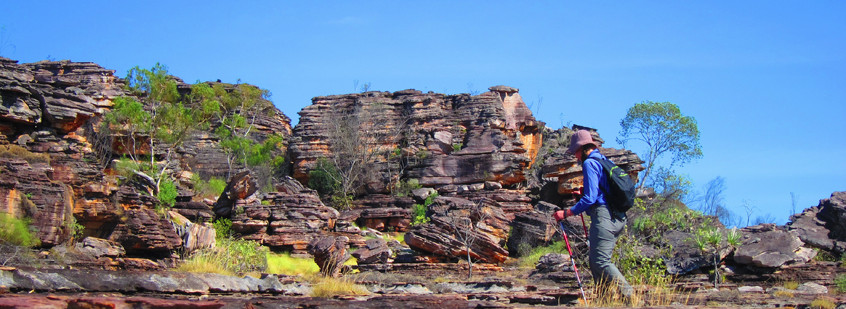The formed track ends at Gubara Pools, a series of spring-fed waterholes on the Baroalba Creek. Mournful birdcalls whistle and crack in the shady monsoon forest surrounding the pools, while dragonflies chase each other over the surface of the water. If all goes to plan Baroalba Creek will provide a breach in the escarpment above.
“No water problems here at least,” I say, filling my water containers.
“Maybe, but it’s what we find up there that counts,” Yasmin replies.
It’s August, deep in the dry season, and temperatures are in the low 30s. Although we’ve planned a six-day hike, we’re unsure how much water we’ll find further up the creek. And if we can’t find more water we will have to turn around and head back.
We follow the creek eastwards over jumbles of boulders and snarls of fallen logs. The footing is treacherous and our packs are heavy, making progress slow. There is a feeling of envelopment as orange cliffs rise beside us and fan palms seal off light from above. In the deep shade hundreds of common crow and blue argus butterflies flutter like a shifting kaleidoscope.
A series of awkward, car-sized boulders require us to remove our packs and heave them over the rocks by hand. With six days’ food and seven litres of water each we have to earn every metre gained. A great bowerbird watches our struggles from a nearby branch, head cocked to one side. As I put my pack back on, red-faced and sweating, I brush against a shrub. The bowerbird continues to watch, seemingly astonished, as I hop around swearing and swatting at my face and neck.
“Green ants?” Yasmin asks sympathetically, brushing the insects from my hair. “Funny how they always seem to find you.”
“Hilarious. Ow!”
When I’ve dislodged the last of the ants we continue along the creekbed, slowly gaining elevation as we clamber over boulders, rocks and stone slabs. Although the creek has now stopped flowing, there are still regular pools of water. The small bronze-coloured frogs resting in the shallows leap away at our approach.
After a detour around an impassable wall of rock – surely a spectacular seven-metre high waterfall in the wet season – we stop, look mutely at one other, and drop our packs. It doesn’t matter that we’ve only struggled three kilometres from Gubara Pools. There is no doubt that this is the place to camp.
A beach of fine white sand fringes a deep waterhole with an inviting jade tinge like thick glass. Around the pool are banks of yellow fairy-apron flowers, hedges of lime green rope-rush and water-smoothed platforms of deep red rock…
…the journey continues in Wild issue 145.


